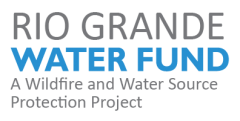The Rio Grande Water Fund is dedicated to making science-informed decision making about actions needed to restore watershed health. Studies are carried out through partnerships with academic and agency scientists, and sometimes by commissioning specific expertise.
Economics
- Economic Effects of Wildfire Risk Reduction and Source Water Protection Projects in the Rio Grande River Basin in Northern New Mexico and Southern Colorado (Chris Huber, et al. 2019)
- AP News Article Susan Montoya Bryan 2/14/2020
- Taos Return On Investment Study
- San Juan-Chama Return On Investment Study
- Taos Wood Waste Utilization Assessment
Hydrology
- Impacts of Watershed Restoration and Wildfire on Water Yields and Water Supply Resilience (Mark Stone et al., 2017)
- Sandia and Manzano Mountains Post-fire Debris Flow Risk Assessment (Anne Tillery et al., 2014)
- Jemez Mountains Post-fire Debris Flow Risk Assessment (Anne Tillery and Jessica Haas, 2016)
- New Mexico Post-fire Debris-flow Risk Assessment
- New Mexico Wood Supply Assessment
Fire Ecology
- Surface Fire to Crown Fire: Fire History in the Taos Valley Watershed, New Mexico, USA (Johnson and Margolis, 2019)
- Megafires: an emerging threat to old-forest species (Jones et al. 2016)
- Large population decline and local territory extinctions following the 2014 King Fire
- Habitat selection by spotted owls after a megafire reflects their adaptation to historical frequent-fire regimes (Jones et al. 2020)
- Owls select smaller patches and avoid larger ones, like more complex patches, don’t travel far into large patches
- California spotted owl habitat selection in a fire-managed landscape suggests conservation benefit of restoring historical fire regimes (Kramer et al. 2021)
- Owls prefer recent low-severity burned forest in national parks
Geospatial Data
- Rio Grande Water Fund Boundary (.shp, 325 kb)

